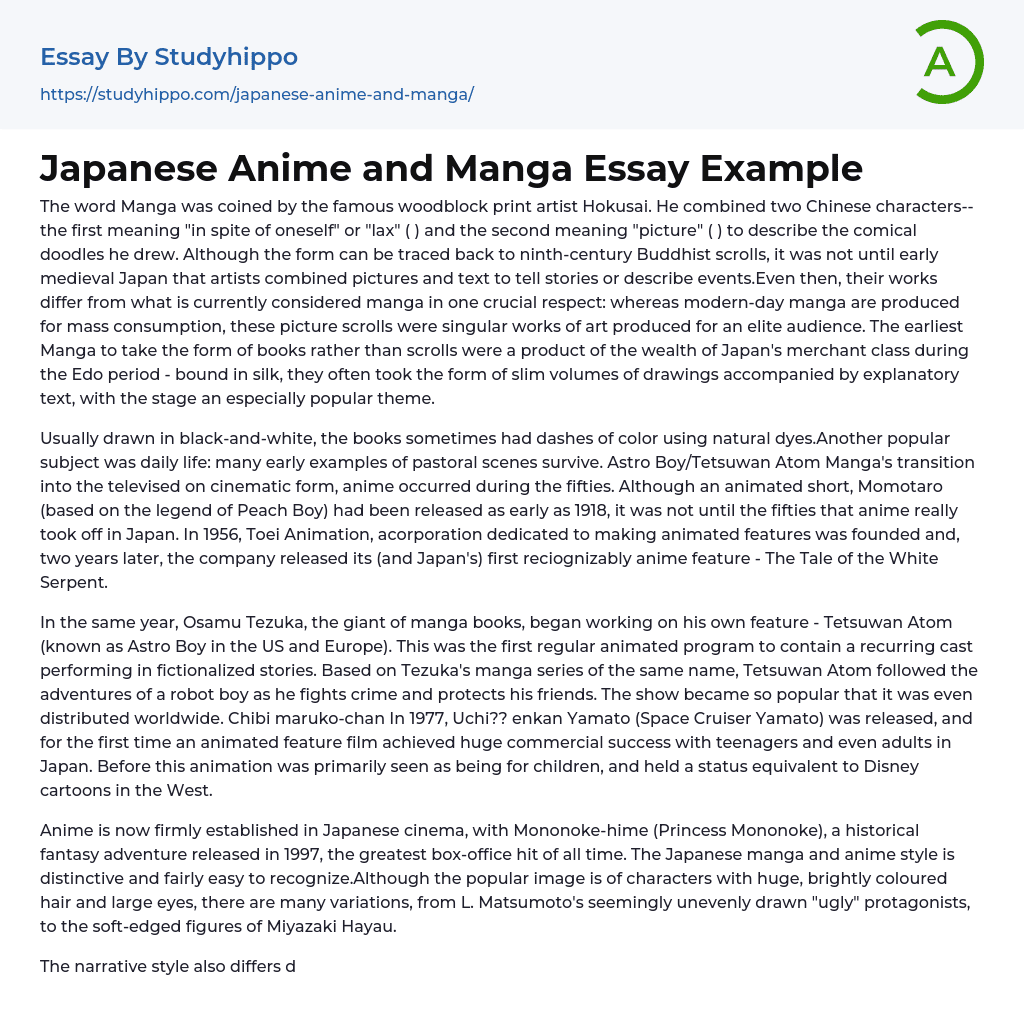Hokusai, a famous woodblock print artist, coined the term Manga by combining two Chinese characters: the first character means "in spite of oneself" or "lax" ( ), and the second character means "picture" ( ). His intention was to describe the comical doodles he drew. Although the origin of this art form can be traced back to ninth-century Buddhist scrolls, it was during early medieval Japan that artists began combining pictures and text to tell stories or describe events. However, there was a crucial difference between their works and contemporary manga. The picture scrolls produced during that time were singular works of art intended for an elite audience, rather than for mass consumption like modern-day manga. It wasn't until the Edo period that Manga began taking the form of books rather than scrolls. These books were produced by Japan's merchant class, and were often
...slim volumes of drawings accompanied by explanatory text. The stage was a particularly popular theme during this era.
The books, typically brought to life in black-and-white, occasionally featured natural dye colors. There were also numerous examples of early pastoral scenes depicting daily life. In the 1950s, the transition from printed manga to televised and cinematic anime occurred. Although an animated short film based on the legend of Peach Boy, Momotaro, had been released as early as 1918, it wasn't until the 1950s that anime gained popularity in Japan. Toei Animation, a company exclusively committed to producing animated works, was established in 1956. Two years later, Toei Animation released Japan's first recognized anime feature entitled The Tale of the White Serpent.
In the year mentioned, Osamu Tezuka, renowned for his manga books, commenced work
on his own creation, Tetsuwan Atom, also known as Astro Boy. This animated program marked the inception of a regular series containing a recurring cast engaged in fictionalized stories. Featuring the adventures of a robotic boy crusading against crime and defending his associates, Tetsuwan Atom was based on Tezuka's manga series by the same title. Its immense popularity led to its distribution worldwide. 1977 saw the release of Uchi?? enkan Yamato, aka Space Cruiser Yamato, the first ever animated movie to attain massive success with teenagers and adults in Japan. Prior to this milestone, animation was typically perceived as children's entertainment and held a status comparable to Disney cartoons in the West.
Japanese cinema has embraced the culture of anime, with Mononoke-hime (Princess Mononoke) becoming the top-grossing film in history since its release in 1997. The unique style of Japanese manga and anime is easily recognizable and characterized by vividly hued hair and big eyes. However, this portrayal varies greatly, from Miyazaki Hayau's gentle figures to L. Matsumoto's "ugly" heroes with uneven drawings.
The style of storytelling in Japanese comics is noticeably distinct from that of Western comics, characterized by greater uncertainty and a lesser focus on heroic figures. A prime example is the Pokemon movie, where the dialogue had to be modified for its release in the United States to provide greater clarity distinguishing the "villains" from the "heroes". In contrast to the West, the most coveted Pokemon T-Shirt in Japan features Pikachu, an adorable character from the show that exceeds sales of those highlighting Ash, the protagonist of the program.
The difference in emphasis on heroes in Western animation is shown here, as well as
the contrasting themes in anime. While death and romance can be depicted in Japanese TV anime shows, they are often removed from American versions deemed unsuitable for children. A prime example is "GoLion" ("Voltron"), which deleted references to a main character's death in the U.S. version.
Anime and manga depict everyday life in Japan, often featuring scenes of students in class or people working in their offices. Although some Western children may find these themes uninteresting, the genres cater to all types of people, including corporate bosses with manga about executives stopping hostile takeovers. Kathleen Kennedy, the executive producer for Steven Spielberg's The Lost World: Jurassic Park, has acknowledged the influence of anime on Western movies. Spielberg's film-making process resembles the composition of an animated film where visuals precede the story, similar to how computer-generated images in Hollywood films are essentially computer-drawn animations. Thus, anime has become a major inspiration for successful animated movies enjoyed by both adults and children, such as Toy Story and Antz.
Anime and manga have gained massive popularity worldwide, including within Japan. Western-made anime films like Titan A. E. further demonstrate the growing trend. Iconic anime series like Pokemon, Sailor Moon, and Dragon Ball have all been incredibly successful across the globe.
It appears that Japanese animation will maintain its success for an extended period.
- Movies essays
- Music essays
- Celebrity essays
- Television essays
- Actors essays
- Roller coaster essays
- Magic essays
- Media essays
- Video Game essays
- Wall Street essays
- Dead Poets Society essays
- A beautiful mind essays
- Sherlock Holmes essays
- Our day out essays
- American Beauty essays
- Do The Right Thing essays
- Forrest Gump essays
- Good Will Hunting essays
- Finding Forrester essays
- Looking For Alibrandi essays
- On The Waterfront essays
- One Flew Over The Cuckoo'S Nest essays
- Rabbit Proof Fence essays
- Remember The Titans essays
- Schindler'S List essays
- Shawshank Redemption essays
- The Blind Side essays
- Titanic essays
- Witness essays
- The Veil essays
- Blade Runner essays
- Monster essays
- The Graduate essays
- Twilight essays
- West Side Story essays
- Like Water For Chocolate essays
- Glory essays
- Superman essays
- Moulin rouge essays
- American Films essays
- Cinema Of The United States essays
- English-Language Films essays
- Film Editing essays
- Film Noir essays
- Film Techniques essays
- Horror essays
- Bollywood essays
- The time essays
- Saving private ryan essays
- The hunger games essays




